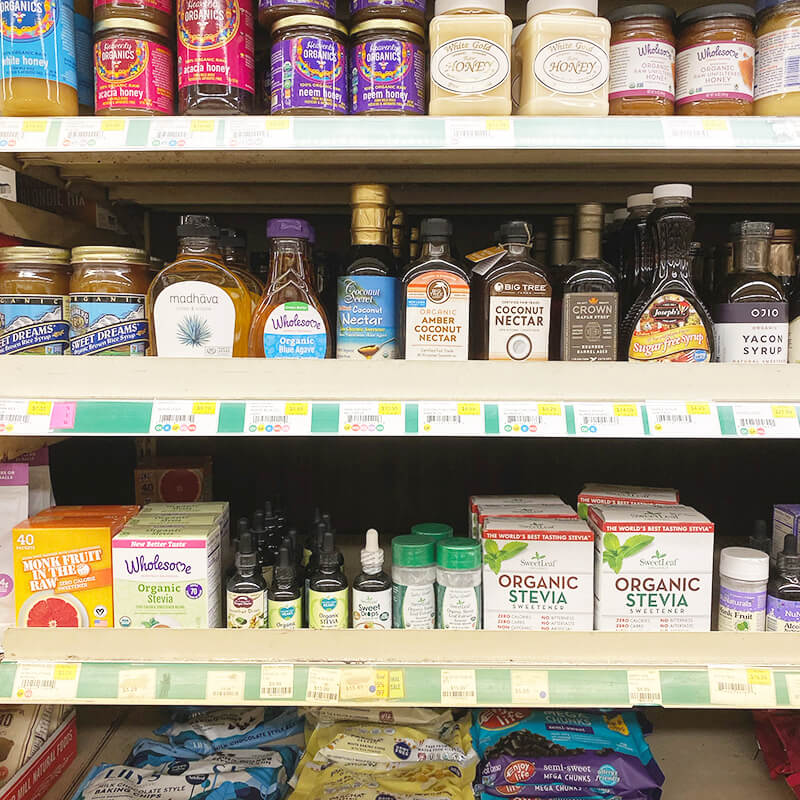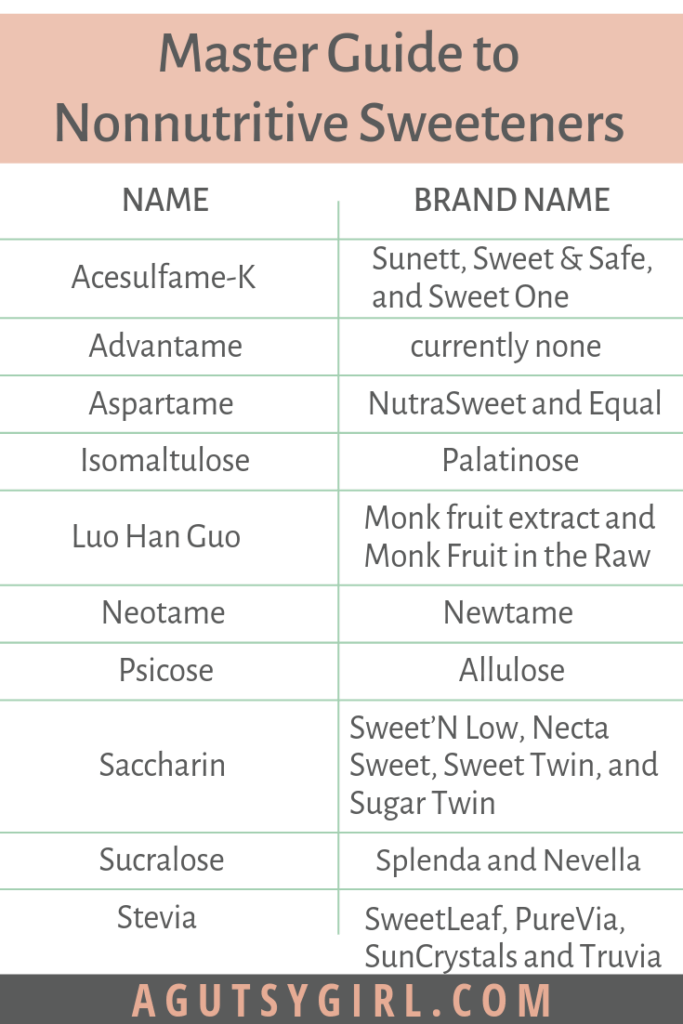Sugar, sugar, and more sugar. Everywhere! Today I’m giving you a master guide to nonnutritive sweeteners.
I was inspired to write this post when a friend asked, “What is allulose, and what do you think about it?”
“Well,” I said, “I’m actually not sure. If it’s an alternative sugar, then it’s a nonnutritive sweetener. So let me put together a post where I can include it.”
I’ve been wanting to put this post together ever since I read The Paleo Approach: Reverse Autoimmune Disease and Heal Your Body. Starting on page 120, she discusses nonnutritive sweeteners.
Diving into this topic was a huge undertaking, but here we go….

What is a Nonnutritive Sweetener?
Might as well start with what a nonnutritive sweetener is so we’re all on the same page.

Table sugar (sucrose, the scientific name for it) is a nutritive sweetener. This means that it provides nutrition.
Calm down! I realize that we don’t think of sugar as being nutritious; that’s not what I’m saying. What it means is that it contains calories and provides energy in the form of carbohydrates.
Examples of nutritive sweeteners include: table sugar, honey, agave, and High-fructose Corn Syrup (HFCS).
A nonnutritive sweetener, though, provides no nutrition. According to the USDA, a nonnutritive sweetener is defined as,
Zero- or low-calorie alternatives to nutritive sweeteners, such as table sugar. These sweeteners can be added to both hot and cold beverages and some can be used for baking. Nonnutritive sweeteners are much sweeter than sugar so only small amounts are needed. They provide fewer calories per gram than sugar because they are not completely absorbed by your digestive system.
But what exactly are nonnutritive sweeteners? How will you know what they are? What are their names? (Because, no, when reading a nutrition label it will not say, “nonnutritive sweetener.”) And is it okay to use them?
Master Guide to Nonnutritive Sweeteners
Click HERE to save this post for later.

Acesulfame-K
Brand names: Sunett, Sweet & Safe, and Sweet One
Acesulfame-potassium (Ace-K), a FDA-approved artificial sweetener, is one of the major low-calorie artificial sweeteners in the modern diet.
Ace-K, like sodium saccharin and sodium cyclamate, belongs to sulfonamides, a chemical class associated with antimicrobial activity.
Some other things about Ace-K:
- In Europe, it’s E950.
- It is around 200 times sweeter than sugar.
- It’s usually found in a blend with other sweeteners such as aspartame and sucralose.
- Acesulfame K isn’t broken down or stored in the body. Instead, it’s absorbed into your system and then passed unchanged in your urine.
- It is stable when heated, which is why it’s commonly found in baked goods.
Advantame
Brand names: currently none (because there are none, it is only currently available to the commercial and food ingredients market)
Advantame is chemically similar to aspartame (Equal). And here are some other things to know about it:
- People with phenylketonuria (PKU) should avoid or limit their use of aspartame. PKU = a rare genetic condition that causes an amino acid called phenylalanine to build up in the body.
- While it’s chemically similar to aspartame, it’s much sweeter. It’s made from a chemical composition of Aspartame and vanillin, both artificial substances.
- How sweet is advantame? 20,000 times as sweet as sugar!
- It was developed by Aijnomoto, a Japanese company, and one of the world’s largest producers of food ingredients.
Aspartame
Brand names: NutraSweet and Equal
Aspartame is very popular. If you eat “diet” foods, chances are you have consumed it within the past 24 hours. Aspartame includes: aspartic acid and phenylalanine. Both are naturally occurring amino acids. And when the body processes aspartame, part of it breaks down into methanol.
Here are some thing so to know about aspartame:
- Methanol is toxic in large quantities, yet smaller amounts may also be concerning as a combination with free methanol because of enhanced absorption.
- Free methanol emerges when aspartame is heated, and when free methanol is consumed regularly it may be a problem. The free methanol breaks down into formaldehyde, a known carcinogen and neurotoxin, in the body.
- Dr. Alan Gaby, MD, reported in Alternative Medicine Review in 2007 that aspartame found in commercial products or heated beverages may be a seizure trigger and should be evaluated in cases of difficult seizure management.
- It is approximately 200 times sweeter than sugar.
- Those with phenylketonuria (PKU) shouldn’t use aspartame, nor should those who are taking medications for schizophrenia.
Isomaltulose
Brand name: PalatinoseTM
It is purely based on sucrose from sugar beet. It is a natural occurring disaccharide composed of alpha-1,6-linked glucose and fructose.
Here are some other things to know about it:
- Commercial isomaltulose is produced from sucrose by enzymatic rearrangement and has been used as a sugar in Japan since 1985.
- Isomaltulose is particularly suitable as a non-cariogenic sucrose replacement and is favorable in products for diabetics and prediabetic dispositions.
- Following isomaltulose ingestion, the rise in the blood glucose concentration is lower than after the intake of table sugar, although both types of sugar are composed of the same simple sugars and are completely digested and absorbed in the small intestine.

Luo Han Guo
Brand names: Monk fruit extract, Monk Fruit in the Raw ®
Luo han guo is a very sweet and round dried fruit typically grown in southern Chinese provinces such as Guangdong, Guizhou, Hunan and Jiangxi. In the U.S., luo han guo or monk fruit is Generally Recognized As Safe (GRAS) for use as a sweetener or flavor enhancer for food and beverages, excluding meat and poultry products.
Here are some other things about luo han guo:
- It may also go by the names “Buddha fruit” or “monk fruit.”
- The extract is 150-250 times sweeter than table sugar, has zero calories and carbs, and does not raise blood glucose levels.
- The luo han guo fruit and its extract is popular in TCM (traditional chinese medicine), and is slowly gaining recognition in other places because of its potential benefits.
- Some of its benefits include: anti-inflammatory properties, anti-aging properties, relieving allergies, helping control diabetes, and boosting immunity.
- Caution if you are allergic to members of the gourd family (which luo han guo belongs to) such as pumpkins, squash, cucumbers and melons.
Brand Feature: Lakanto Sweetener
The Lakanto brand monk fruit sweetener is one that I talk about and use frequently. The ingredients in it are: erythritol and monk fruit extract. Some can’t tolerate the erythritol, but because I use small quantities, I’ve never had a problem.
I do however have problems with Stevia when I have too much.
If you’re looking for a pure monkfruit sweetener, checkout It’s Just HERE.
Note: A study was done that stated erythritol is less likely to cause digestive issues than xylitol.
Neotame
Brand names: Newtame®
Neotame, also known by the trade name Newtame, is a non-caloric artificial sweetener and aspartame analog by NutraSweet.
Here are things to know about Neotame:
- By mass, it is 8000 times sweeter than sucrose, making it 30 times sweeter than its cousin, aspartame. (Depending on how it’s used, it can be up to 13,000 sweeter than sugar!)
- It does not break down under heat, making it suitable for cooking and in processed foods.
- Despite structural similarity of neotame to aspartame, the potential release of phenylalanine from neotame has limits. Therefore, phenylketonuria (PKU) patients can enjoy neotame as well.
- To date, neotame is a permitted sweetener in more than 60 countries/areas such as Mainland China, Australia, New Zealand, the U.S., Canada as well as the European Union where neotame has recently been approved.
- Could be camouflaged under “natural flavors.”
Psicose
Brand names: Allulose
Yes, this one is for you, darling friend!
D-Psicose, also known as D-allulose, or simply allulose, is a low-calorie monosaccharide sugar used by some major commercial food and beverage manufacturers.
Allulose Sweetener
Here are some things to know about the allulose sweetener:
- It is one of many different sugars that exists in nature in very small quantities. It was initially identified from wheat and has since been found in certain fruits including jackfruit, figs and raisins.
- Has the same molecular formula as glucose and fructose.
- Allulose is not metabolized by the body and has no impact on blood glucose.
- Some of its characteristics include: mouthfeel similar to sucrose, improves gelling, tastes like regular sugar, browns and caramelizes when heated, adds texture and bulk, depresses freezing point, extends shelf life, dispenses in batter, and binds with moisture.
- Currently the Quest brand is one of the only to use allulose sweetener, so it’s not a widely used ingredient yet.

Saccharin
Brand names: Sweet’N Low, Necta Sweet, Sweet Twin, and Sugar Twin
Saccharin was discovered in the 1870’s by Ira Remsen and Constantine Fahlberg, researchers at Johns Hopkins University. It is about 200-700 times sweeter than sugar.
Some things to know about saccharin include:
- It is not broken down during digestion, passing through the body unchanged.
- It’s the oldest low- or no-calorie sweetener on the market approved for use.
- Saccharin is made in a laboratory by oxidizing the chemicals o-toluene sulfonamide or phthalic anhydride.
- It can have an unpleasant, bitter aftertaste.
- Common uses include: baked goods, jams, jelly, chewing gum, canned fruit, candy, dessert toppings, and salad dressings.
- In Europe, it’s E954.
Sucralose
Brand names: Splenda and Nevella
Sucralose is a zero-calorie artificial sweetener, and Splenda is the most common sucralose-based product. It is made from sugar in a multi-step chemical process in which 3 hydrogen-oxygen groups are replaced with chlorine atoms.
Other things to know about sucralose:
- In Europe, it’s the E number E955.
- Sucralose is a versatile sweetener, so you’ll find it sweetening up many foods, including diet drinks, chewing gum, gelatin and frozen desserts.
- Splenda products were then jointly developed by the companies Tate & Lyle and Johnson & Johnson.
- Baking with it may be harmful, as it seems that at high temperatures, it starts to break down and interact with other ingredients.
Stevia
Brand names: SweetLeaf (inulin), PureVia (dextrose and cellulose), SunCrystals (cane sugar), and Truvia (erythritol)
I have had periods where I was obsessed with stevia, consuming it on the daily.When my gut was a mess, though, I noticed a correlation between stevia and cystic back acne. For a long time, I cut it out of my diet completely.
Today, I consume it in small amounts, from time-to-time.
Stevia is an intensely sweet-tasting plant with uses for sweeten beverages and make tea since the 16th century. The plant is originally native to Paraguay and Brazil but is now also in Japan and China. You’ll see it as a non-nutritive sweetener and herbal supplement.
Here are more things to know about stevia:
- Stevia tastes 200 to 300 times sweeter than table sugar.
- It is a bushy shrub that is part of the sunflower family.
- Stevia plants, also known as sweet leaf, are perennial shrubs native to Paraguay that include over 150 different species.
- Stevia is not artificial
Sources: HERE, HERE, HERE, HERE, HERE, HERE, HERE, HERE, HERE, HERE, HERE, HERE, HERE, HERE, HERE, HERE, HERE, HERE, HERE, HERE, HERE, and HERE.
Swerve Sweeteners
Another common nonnutritive sweetener is the Swerve Sweetener.
This product is another alternative sweetener that claims to not have the “bitter aftertaste associated with other sweeteners like stevia and monkfruit.” (Side note: I do think stevia has an aftertaste, but I do not think monkfruit does.)
Their most basic product, the granular, contains these three ingredients: erythritol, oligosaccharides, and natural flavors. This product replaces regular sugar 1-to-1 in recipes.
When considering whether or not this nonnutritive sweetener is for you, refer back to my post on oligosaccharides. Based on that post, you might know immediately whether or not the Swerve Sweetener is right for you.
Finally, natural flavors are the third ingredient. It may or may not be okay for you. The term is ambiguous and mammoth.
Read more about natural flavoring HERE.
Are Nonnutritive Sweeteners OK to Consume?
After all my research, this is the conclusion:
The dose makes the poison.
And I have correlated my conclusion to the LDN I take on a daily basis.
Naltrexone HCl was approved by FDA in 1984 for the treatment of opioid addiction. The typical daily dosage for opioid addiction is 50.0–100.0 mg daily, and 50.0-mg tablets are available commercially.
In lower doses, LDN (Low Dose Naltrexone) (in most published research this is 4.5 mg – exactly what I take), “exhibits paradoxical properties, including analgesia and anti-inflammatory actions, which have not been reported at larger dosages.”
I Still Don’t (Fully) Trust the FDA
That said, I’m still not confident that the dose which the FDA deems OK is actually OK.
Research reveals that many nonnutritive sweeteners impact gut bacteria and the lining of the intestines.
On the one hand, studies have shown that artificial sweeteners can have a detrimental effect on the bacteria in the intestine. In the trials several artificial sweeteners, including Saccharin, Aspartame and Sucralose had the effect of promoting glucose intolerance.
But on the other hand, on the basis of the data reviewed it was concluded that the use of isomaltulose as an alternative sugar is as safe as the use of other digestible sugars consisting of glucose and fructose.
Scientists are curious over the fact that artificial sweeteners do not seem to assist in weight management. The effect of promoting glucose intolerance may explain the issue.
While I do not prescribe to the theory that consuming even minute amounts of nonnutritive sweeteners completely destroys the gut and can contribute to a cause of cancer, I DO believe in the correlation.
Multiple studies (below) have confirmed it, though more research needs to be done.
And it’s not just the multiple studies – just think about all the gut imbalance and increasing cancer rates, even with the ultra-healthy “diet” culture. Coincidence? I don’t think so, but you can decide for yourself.
Sources: HERE, HERE, HERE, HERE, and HERE.
What are Some (Good) Alternative Natural Sweeteners (to Nonnutritive Sweeteners)?

There are many forms of natural sweeteners.
Here are some to consider:
- agave (high-FODMAP)
- coconut sugar (low-FODMAP)
- honey (high-FODMAP)
- maple syrup (low-FODMAP)
- molasses (high-FODMAP)
More about FODMAPs HERE.
But don’t kid yourself, sugar – both natural and artificial – is far more than what has been discussed today.
In fact, if you want 192 Sources and Alternate Names for Sugar, grab them HERE.
If you’re trying to heal your gut and have a sweet tooth, you might want to check out Gut Healing with a Sweet Tooth HERE.
If you liked this post, you might also enjoy:
Xox,
SKH
🤰 bloating be gone! weight loss through optimal gut health for women
💃ʜᴇᴀʟ ʏᴏᴜʀ ɢᴜᴛ. ʜᴇᴀʟ ʏᴏᴜʀ ʟɪfe.
🫶🏻 founder gutbyome.com








“I still don’t (fully) trust the FDA”
🤣 who does? Thank you for all your hard work! I appreciate you, my gut appreciates you ❤
Ha ha!!! But you know?!